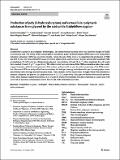Por favor, use este identificador para citar o enlazar a este item:
http://hdl.handle.net/10261/340958COMPARTIR / EXPORTAR:
 SHARE SHARE
 CORE
BASE CORE
BASE
|
|
| Visualizar otros formatos: MARC | Dublin Core | RDF | ORE | MODS | METS | DIDL | DATACITE | |

| Título: | Production of poly (3‑hydroxybutyrate) and extracellular polymeric substances from glycerol by the acidophile Acidiphilium cryptum |
Autor: | González, Ernesto; Zuleta, Camila; Zamora, Guiselle; Maturana, Nataly; Ponce, Belén; Rivero-Buceta, Virginia CSIC ORCID; Rodríguez, Alberto; Soto, Juan P.; Scott, Felipe; Díaz-Barrera, Álvaro | Palabras clave: | Acidiphilium cryptum Acidophile Extracellular polymeric substances Extremophile Glycerol poly(3- hydroxybutyrate) |
Fecha de publicación: | 17-oct-2023 | Editor: | Springer | Citación: | Extremophiles 27:30 (2023) | Resumen: | Acidiphilium cryptum is an acidophilic, heterotrophic, and metallotolerant bacteria able to use dissolved oxygen or Fe(III) as an electron sink. The ability of this extremophile to accumulate poly(3-hydroxybutyrate) (PHB) and secrete extracellular polymeric substances (EPS) has also been reported. Hence, the aim of this work is to characterize the production of PHB and EPS by the wild strain DSM2389 using glycerol in shaken flasks and bioreactor. Results showed that maximum PHB accumulation (37–42% w/w) was obtained using glycerol concentrations of 9 and 15 g L−1, where maximum dry cell weight titers reached 3.6 and 3.9 g L−1, respectively. The culture in the bioreactor showed that PHB accumulation takes place under oxygen limitation, while the redox potential of the culture medium could be used for online monitoring of the PHB production. Recovered EPS was analyzed by Fourier-transform infrared spectroscopy and subjected to gas chromatography—mass spectrometry after cleavage and derivatization steps. These analyses showed the presence of sugars which were identified as mannose, rhamnose and glucose, in a proportion near to 3.2:2.3:1, respectively. Since glycerol had not been used in previous works, these findings suggest the potential of A. cryptum to produce biopolymers from this compound at a large scale with a low risk of microbial contamination due to the low pH of the fermentation process. | Descripción: | 11 p.-5 fig.-2 tab. | Versión del editor: | https://doi.org/10.1007/s00792-023-01313-3 | URI: | http://hdl.handle.net/10261/340958 | DOI: | 10.1007/s00792-023-01313-3 | ISSN: | 1431-0651 | E-ISSN: | 1433-4909 |
| Aparece en las colecciones: | (CIB) Artículos |
Ficheros en este ítem:
| Fichero | Descripción | Tamaño | Formato | |
|---|---|---|---|---|
| Extremophiles_González_2023.pdf | Artículo principal | 1,59 MB | Adobe PDF |  Visualizar/Abrir |
CORE Recommender
Page view(s)
13
checked on 17-may-2024
Download(s)
19
checked on 17-may-2024
Google ScholarTM
Check
Altmetric
Altmetric
NOTA: Los ítems de Digital.CSIC están protegidos por copyright, con todos los derechos reservados, a menos que se indique lo contrario.
